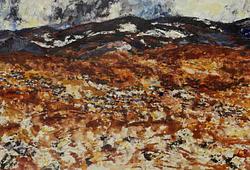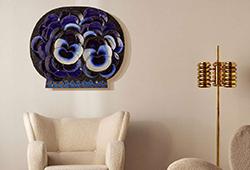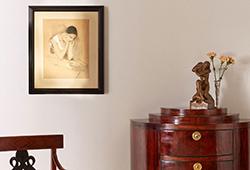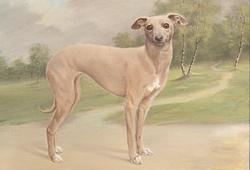Jean (Hans) Arp
"Amphore de Muse"
Signed HA and numbered I/III. Concieved in 1959 and cast in the same year. Bronze, gold patina. Height 121 cm (47 5/8 in.), total height including stone base 171 cm (67 1/4 in.).
Note: If your online bid exceeds SEK 3 million, you will need a bank reference. Please contact our customer service to be cleared for this level of online bidding.
Alkuperä - Provenienssi
Galerie Denise René, Paris.
Marabou Collection, Sundbyberg/Upplands-Väsby, Sweden (aquired from the above in 1960).
Kraft Foods Sverige AB, Upplands-Väsby, Sweden.
Näyttelyt
Moderna museet, Stockholm, Sweden, "Önskemuseet", 26 December 1963 - 23 February 1964, no 66.
Kirjallisuus
Eduard Trier, "Hans Arp, Skulpturen 1957-1966", 1968, compare p. 23 and listed p. 109, no 183.
Ragnar von Holten, "Art at Marabou, a short guide", 1974, illustrated p. 16 and mentioned pp. 16-17.
Ragnar von Holten, "Art at Marabou", 1990, illustrated and mentioned p. 6.
Muut tiedot
Receipt from Galerie Denise René, Paris enclosed.
The sculpture “Amphore de Muse” epitomises the essence of fantastic form, a remarkable idea that is brought into being in bronze. It could almost be described as an abstract sculpture, since it is not directly figurative, but its lines and shifting surfaces nevertheless enable us to identify patterns and figures. The work immediately activates our eyes and offers such a multifaceted impression that even our tactile sense is involved. The rounded contours play exquisitely against the shiny, terser surfaces, and the overall effect is of an autonomous form in complete harmony that entices us to caress the billowing lines with our hands.
The artist behind this work, Jean Arp, was one of the pioneers of Dadaism, but also one of the bold artists who broke new ground by working exclusively with abstract elements in both painting and sculpture, using every conceivable material, including textiles, to give shape to his ideas.
Jean (Hans) Arp was born in Strasbourg. He studied at the Academy of Art in Weimar in 1905-1907, where he encountered the modern tendencies in art, but soon moved on to Paris, where he studied in 1910 at the Académie Julian. At the outbreak of the First World War, his family moved to Switzerland. Jean Arp’s mother stemmed from the neutral Alpine region, and the family settled in Weggis, in the German-speaking part of the country. Jean Arp was thus spared some of the wartime hardship and spent much of his time in Zürich. He took an early interest in abstract art, and by 1911 he was already producing his own abstract sketches. On his study trips and sojourns in Paris and Munich he made friends with Robert Delaunay and Wassily Kandinsky, and had the opportunity to exhibit his abstract work, for instance at Der Sturm’s Autumn Salon in 1914. In Zürich he met the “universal artist” Hugo Ball, who started Cabaret Voltaire – a form of experimental workshop for the arts, housed in a small, modest restaurant, where visitors were entertained with unconventional concerts, modern music with classical elements, readings of nonsense poetry, modern dance, etc. Here, Jean Arp met Tristan Tzara and Richard Huelsenbeck, who used mainly words as their artistic medium. They also produced a magazine together. Jean Arp became the main illustrator for these two poets – and the close collaboration with Tristan Tzara continued throughout Jean Arp’s life. The circle also included the dancer and artist Sophie Tauber, whom Jean Arp married in 1922. The group grew, and the members sought new forums for their ideas. In 1917, Galerie Dada opened, where Jean Arp exhibited his work and contributed frequently to the gallery’s publication. From initially being a loose group of intellectual “anti-traditionalists”, Cabaret Voltaire gradually grew more radical. The name “Voltaire”, which signalled intellectualism, was exchanged for “da-da” – a word as meaningless as baby talk. This group of young artists, musicians and poets was in search of something beyond the established movements - Expressionism, Futurism and Symbolism were deplorable and demoralising – since they had promoted war, according to the Dadaists.
In 1917-1918, the group dissolved, however, and Jean Arp took off for Cologne, where he formed Dada Köln in 1919 together with Max Ernst and Johannes Baargeld. The time in Cologne was highly productive; among other things, they experimented with quirky collages, so-called Fatagagas (Fabrication de tableaux garantis gazométriques). Dadaism was a reaction, partly against the emerging modern society, and partly against the artistic ideal favoured and hailed by it. But more than anything else, it was a literary movement. According to the Dadaists, “Art” was nothing but an illusion of no particular value. What had Modernism achieved? Wasn’t it a fact that the best Cubism was an excellent example of an academic discipline that appealed to the educated intellectual classes? Hadn’t the Futurists glorified war? Instead, Jean Arp and his fellow artists pioneered performance art – preferring the transient, that which could not be preserved or conserved – that which could not be “captured and put into a museum” was seen to be genuine art.
In his work, Jean Arp challenged, rather than created, art; he used old methods and styles, but in new contexts. In the 1930s, he increasingly applied himself to making sculptures or three-dimensional objects. But the starting point for his work was still the same. He preferred open, individualised shapes based on the human body, and distanced himself at an early stage in his career from Expressionism, in favour of abstract form. These forms do not always originate in any actual object, but can be seen more as organic, evolving shapes. Jean Arp also liked to combine his organic shapes with more realistic elements - all according to the laws of chance, as he expressed it. “Amphore de Muse” is a fine example of this artistic intention, which also meant that the artist’s composition was influenced by external factors, such as wind, gravity, and so on. Relinquishing the traditional artist role - that of the inspired master - is a characteristically Dadaist approach.
The sculpture “Amphore de Muse” is from Jean Arp’s late oeuvre but is considered to be one of his more aesthetic works. The approach is related to certain Surrealist ideas, where the finished work originates in uninhibited, uncensored and uncontrolled dreaming. Jean Arp’s artistic practice can be compared to a magician who finds his inspiration in the random shapes of nature.




























